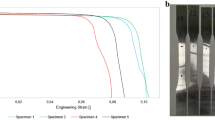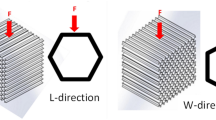Abstract
By combining honeycomb core with the traditional crash box, an innovative foam-filled honeycomb core structure crash box is proposed to improve safety performances. Three kinds of honeycomb core crash boxes were obtained by filling the inside of the traditional crash box with the quasi-honeycomb core, the quasi-square honeycomb core and hexagonal honeycomb core. It is deduced that the energy absorption of the quasi-honeycomb core crash box increased by 42.2 %, the peak of the collision force reduced by 8.9 %. The hexagonal honeycomb core crash box and the quasi-square honeycomb core crash box also enhance the energy absorption characteristics, but the peak impact force increased by 5.6 % and 9.6 %. After filling of the Expanded Polypropylene (EPP) foam, the peak collision force of the EPP hexagonal honeycomb core crash box and the EPP quasi-square honeycomb core crash box increased by 10 %, while Fmax of the EPP quasi-honeycomb core crash box reduced by 2.3 % and the energy absorption increased by 54.6 %. Six structures were compared to highlight the energy absorption characteristics of the filling the inside of the traditional crash box with the light in weight honeycomb core and EPP foam. The research results provide a new idea for the design of crash box.
Similar content being viewed by others
References
Cho, J. U., Hong, S. J., Lee, S. K. and Cho, C. (2012). Impact fracture behavior at the material of aluminum foam. Materials Science and Engineering: A, 539, 250–258.
Jamian, S., Zainal Abidin, M. R. and Muda, A. M. (2015). Crashworthiness behavior of hollow Al-based functionally graded material (FGM) box under quasi-static loading. Applied Mechanics and Materials, 773, 110–114.
Kang, S. (2016). Bumper stay design for RCAR front low speed impact test. Trans. Korean Society of Automotive Engineers 24,2, 191–197.
Lee, S. K., Cho, C. D., Cho, J. U. and Bang, S. O. (2011). Inplane characteristics of Al foam core and Al honeycomb core sandwich composites with an indented damage. Annual Conf. KSME, 1, 226–227.
Liu, Y. and Ding, L. (2016). A study of using different crash box types in automobile frontal collision. Int. J. Simulation: System, Science and Technology 17,38, 21.1–21.5.
Omkar B. G., Krishna, S. P., Prachant, K. T., Amit, M. W. and Sagar, P. C. (2018). Analysis and experimental validation of crash box for the energy absorption capacity. Research & Reviews: J. Engineering and Technology 7,1, 11–14.
Shin, M. K., Yi, S. I., Kwon, O. T. and Park, G. J. (2008). Structural optimization of the automobile frontal structure for pedestrian protection and the low speed impact test. Proc. Institution of Mechanical Engineers, Part D: J. Automobile Engineering 222,12, 2373–2387.
Sun, Z., Shi, S., Guo, X., Hu, X. and Chen, H. (2016). On compressive properties of composite sandwich structures with grid reinforced honeycomb core. Composites Part B: Engineering, 94, 245–252.
Tanlak, N. and Sonmez, F. O. (2014). Optimal shape design of thin-walled tubes under high-velocity axial impact loads. Thin-Walled Structures, 84, 302–312.
Tarigopula, V., Langseth, M., Hopperstad, O. S. and Clausen, A. H. (2006). Axial crushing of thin-walled high-strength steel sections. Int. J. Impact Engineering 32,5, 847–882.
Wang, C., Li, Y., Zhao, W., Zou, S., Zhou, G. and Wang, Y. (2018). Structure design and multi-objective optimization of a novel crash box based on biomimetic structure. Int. J. Mechanical Sciences, 138, 489–501.
Zhou, G., Ma, Z. D., Li, G., Cheng, A., Duan, L. and Zhao, W. (2016). Design optimization of a novel NPR crash box based on multi-objective genetic algorithm. Structural and Multidisciplinary Optimization 54,3, 673–684.
Zhu, Y., Li, L. and Yang, J. (2011). Frontal structure improvement on car based on RCAR impact test. Infats International Forum of Automotive Traffic Safety.
Acknowledgement
This research work was supported by Yichang Key Laboratory of Robot and Intelligent System, China Three Gorges University, Yichang 443002, China (JXYC00015), the Hydropower Machinery Equipment Design and Maintenance Hubei Provincial Key Laboratory Open Fund Project (2017KJX04) and Sponsored by Research Fund for Excellent Dissertation of China Three Gorges University (2020SSPY034). The authors would like to express their appreciation for above fund supports.
Author information
Authors and Affiliations
Corresponding author
Additional information
Publisher’s Note
Springer Nature remains neutral with regard to jurisdictional claims in published maps and institutional affiliations.
Rights and permissions
About this article
Cite this article
Li, X., Wang, Y., Xu, X. et al. Energy Absorption Characteristics of Crash Box of New Honeycomb Core Structure with Foam-Filled. Int.J Automot. Technol. 22, 221–230 (2021). https://doi.org/10.1007/s12239-021-0022-6
Received:
Revised:
Accepted:
Published:
Issue Date:
DOI: https://doi.org/10.1007/s12239-021-0022-6




